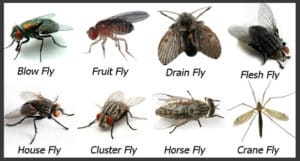Fly Nuisance
There are several species of flies causing fly worry in cattle, horses, goats and dogs.
Adult Stable Fly (Stomoxys calcitrans) has rasping teeth with blades to attack the skin of animals. They feed off the blood and exudate from wounds on the animal. Crusted ulcerated ear wounds are often created from the fly’s bite. The lesion may be itchy and certainly the flies worry the animal.
House Flies cause minor nuisance feeding on the eye and nose secretions and wound exudate.
Horse Flies (Tabanids) bite pieces of skin out to feed on the exudate and blood. The bite is painful.
Deer Fly (Chrysops) and Mosquitoes also cause annoying bites. All insect bites can cause allergies greatly increasing the irritation and itch.
Fly Maggots can infest old animals that become wet from urine scald and cannot move or clean themselves adequately.
Buffalo Flies (Haematobla irritans) are a severe problem in tropical Australia during the late summer.
The most common problem in dogs is fly-bite dermatitis of their ears but other parts of their bodies can also be targeted.
Certain breeds (German Shepherds, Labrador retrievers) seem especially prone and also individual dogs seem to get more severely affected.
The problem is most apparent during the warmer months in Sydney, the time when flies are about and breeding.

Management
It is important to rid your yard / environment of any likely breeding grounds for flies such as compost heaps. Providing dogs with a fly-free area to escape to can be helpful – placing “ribbons” on doors to kennels / sheds / laundry can allow dogs to brush flies off when entering.
Prevention is better than cure – in dogs that are prone to this condition, once their ears have been bitten and are weeping or forming scabs, this acts as a beacon to the flies; so it’s best to start applying deterrents to your dog’s ears early in the fly season before the problem gets too advanced.
Fly and Insect Repellents
There are a number of products used to deter flies from your dog’s ears or wherever they are causing a problem.
Repel-X is a spray designed to be sprayed 2 to 3 times daily over your dog.
Fly Repella Cream is also designed to be applied 2 to 3 times daily to the affected areas.
One of the problems with many of these repellents is their duration of action. Often owners are away during the day and unable to apply the repellents frequently enough.
Permoxin is one of the more effective and longer-lasting products. Dogs can be wet down, rinsed or sprayed with Permoxin in water according to the bottle directions. Repeat as required by fly pressure.
In particularly difficult swarms, a prolonged action can be obtained by mixing Permoxin with white petroleum jelly (Vaseline) and mineral oil (baby oils).
- Dilute 1ml Permoxin in 40ml of Vaseline or baby oil & mix well.
- If a consistency less than the thick Vaseline or more than baby oil is desired, these two ingredients can be mixed in the correct proportions to give the desired consistency after the Permoxin is added.
- Add the baby oil/Permoxin mixture to the Vaseline/Permoxin mixture a little at a time until the desired ointment consistency is reached.
This will keep for the summer months, then discard. This ointment can be applied on wounds to help healing and prevent flies from further irritating the wound.
Apply as frequently as is necessary to keep the flies away.
In some instances a cortisone and/or antibiotic cream may be necessary for secondary infection and to reduce itching.
If you are concerned please contact us to either speak with a vet or to arrange an appointment.








